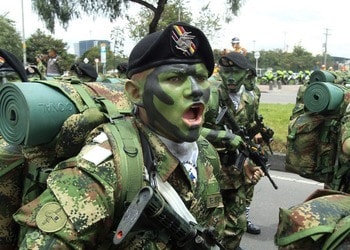Colombia is sending thousands of troops to a border region with Venezuela, where two high-profile attacks were recently carried out by a FARC dissident cell. Still, the ultimate consequences of this deployment remain to be seen.
On July 24, Colombia announced that 14,000 troops would be deployed to Norte de Santander, a northern department bordering Venezuela, to dismantle the 33rd Front and capture its leader, Javier Alonso Veloza García, alias “Jhon Mechas” or “Jhon Milicias.”
The 33rd Front is part of a fragmented network of groups formerly belonging to the now-demobilized Revolutionary Armed Forces of Colombia (Fuerzas Armadas Revolucionarias de Colombia – FARC), known as the ex-FARC Mafia. It has taken responsibility for two notable attacks against Colombian authorities in recent months.
On June 15, a van carrying 30 kilograms of explosives blew up inside the headquarters of the Colombian Army’s 30th Brigade in Cúcuta, the capital of Norte de Santander. The attack injured 34 soldiers and two civilians.
On June 25, shots were fired at a helicopter carrying Colombia’s President Iván Duque and several ministers when it tried to land in Cúcuta. The helicopter was hit several times, but no one was harmed.
SEE ALSO: ELN Car Bomb in Bogotá Takes Fight to Colombia’s Cities
Colombia’s attorney general, Francisco Barbosa, blamed the attacks on the 33rd Front, who promptly admitted to it in a video of their own.
This led the government to order the deployment of the 14,000 troops and to announce a reward of 600 million Colombian pesos ($150,000) for the 33rd Front’s leader, Javier Alonso Veloza García, alias “Jhon Mechas” or “Jhon Milicias.”
InSight Crime Analysis
This military deployment places the 33rd Front as a new security priority in Colombia. But despite two high-profile attacks, this group does not appear to be a national threat, raising questions as to whether the size of the response is justified.
First, the 33rd Front did not act in a vacuum. While the 33rd Front was a known element among dissident FARC groups, these two attacks marked a significant escalation in its status among Colombia’s criminal threats. The group has long supported attempts by seasoned FARC commander Miguel Botache Santillana, alias “Gentil Duarte,” to reunite fragmented fronts into a single fighting force. According to Colombian military intelligence cited by El Tiempo, its leader, John Mechas, joined the FARC in 1996 and worked his way up to command the 33rd Front in 2016.
As aforementioned, the 33rd Front is part of a coalition of former FARC groups led by Duarte. In May 2020, the 33rd Front released a video publicly recognizing Duarte’s leadership. According to army intelligence sources, while the 33rd Front is believed to number around 200 men, Duarte may have up to 3,000 men under his control in Colombia and Venezuela. And while authorities have repeatedly tried to capture Duarte, he remains at large.
According to investigators within an international organization present in Norte de Santander, who requested to stay anonymous for security reasons, the 33rd Front has acted directly under orders from Duarte in the past. On several occasions, John Mechas and the 33rd Front have fought off and killed members of the Segunda Marquetalia, a rival faction of FARC dissidents, InSight Crime learned.
There is no information indicating whether Duarte personally ordered either the attack on the presidential helicopter or on the 30th Brigade.
Second, the 33rd Front has an easy getaway route into Venezuela. Open hostility between Bogotá and Caracas has allowed numerous Colombian criminal groups to use Venezuela as a refuge. The 33rd Front has been known to operate out of the state of Zulia inside Venezuela.
In 2021, clashes between former FARC groups and Venezuelan forces have escalated drastically. But Mechas and the 33rd Front could still go to ground where Colombian troops cannot enter. President Duque did not help matters on July 26 by asking the United States to list Venezuela as a state sponsor of terrorism for sheltering former FARC guerrillas.
Third, there is legitimate concern about what this deployment can truly achieve. While the new force will reinforce existing police and military missions in Norte de Santander, it has clearly set its sights on the 33rd Front. But identifying the whereabouts of John Mechas and his troops in a region rife with criminal threats and with a hard border the Colombian Army cannot cross will prove difficult.

